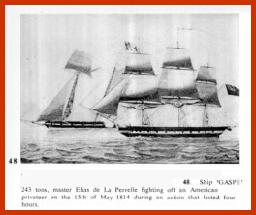Gaspee Virtual
Archives Virtual
Archives |
| False Pathways
in Researching
the Gaspee by Dr. John
Concannon
Webmaster, Gaspee Virtual Archives |
|
Like many things in history, the investigation of affairs from many years ago can come across confusing similarities of names, towns, and events that, while of the same time period, are really not related to one's focus of interest. So it is with the Gaspee Incident, particularly in view of Internet search engine results. We therefore offer the following list of 'False Pathways' in researching the Gaspee. 1. Search inquiries for the term 'Gaspee' will return different results when using various spellings. Gaspee returns, by far the most results. Gaspee, Gaspée, Gaspe, Gaspé and will return smaller subsets of totally different information. It seems that the accented é is treated as a totally different letter than e by most search engines, so beware. 2. Of course there is the Gaspé Peninsula (variously spelt Gaspe, Gaspée, and Gaspee) that sits at the South side of the mouth to the St. Lawrence River on the Atlantic Coast of Canada. This is, presumably, the area for which the first Gaspee was named.
There was actually a Gaspé class of smaller fishing schooners produced in Eastern Canada in the late 18th century. There were also several small merchant ships built on the Gaspé Peninsula and named Gaspee over the succeeding years, though none were of known historical interest. Over time, the US Navy has had some fleet support ships named the Gaspee. Of local note, there was the tugboat Gaspee that plied Rhode Island waters for many years and is now a sunken relic of interest to divers in the Providence River. There is reportedly a picture of this Gaspee "entwined in the cribbing of the India Point drawbridge" after the 1938 hurricane in a book about this disastrous storm published by the Providence Journal. 4. There was apparently a bishop in China by the name of Gaspee in the 1920s. 5. The Providence Amtrak train station is located on Gaspee Street in downtown Providence, RI adjoining the State Capitol. Interestingly, this location is close to the original site of Sabin's Tavern at which the planning was conducted for the raid on the Gaspee in 1772. Several area fire departments also named fire engines after the Gaspee. 6. The Brown
University astronomy section and Johnson
& Wales University (a culinary arts and
business college in
Providence)
both have computer servers named 'Gaspee'. There
was once, in an
earlier, happier time, a local telephone exchange,
GAspee-the 421
exchange 7. Known RI businesses with the name Gaspee include: Gaspee Automotive Warehouse, Gaspee Benefits Planners, and the Gaspee Insurance Agency. None of these have a web presence as of 2001. Very ironically, there was in the 19th century, a Gaspee Fire and Marine Insurance Company. Boy, talk about a very bad choice of corporate name! 8. There are two neighborhoods in Warwick, RI that use Gaspee in their name. The Gaspee Plateau neighborhood is surrounded to the East and South by Narragansett Parkway (the route of the Gaspee Days Parade) and is a sought after, middle class, family-friendly, nice place to live. The Gaspee Point neighborhood consists of privately owned land adjoining the actual Gaspee Point where the HMS Gaspee ran aground and was burnt in 1772. Houses here consist mainly of converted summer cottages with scenic views of Narragansett Bay. Access to this neighborhood is restricted during the summer months by a security guard. 9. Lest you forget, the location of the Gaspee Incident was PAWTUXET, RHODE ISLAND. Do not confuse this quaint village with PAWTUCKET, RI, a city north of Providence; or with PAWCATUCK, a river in the Westerly area of Rhode Island; or with PATUXENT (pronounced Pawtuxet--no 'n'), a well-known river area in Maryland. For an amusing discussion on this point, visit: http://www.whipple.org/docs/paws.html |
| Back to Top | Back to Gaspee Virtual Archives |
 3.
There were several ships over time named the Gaspee.
The
first
recorded Gaspee was the object of our interest,
the British
revenue
schooner Gaspee, burnt by Rhode Island patriots
in 1772.
Subsequently,
the British built a bigger ship, a Brigantine,
named the Gaspee that figured prominently in the
Battle of Montreal
during the Revolution, and patriot Ethan Allen was kept
prisoner in its
brig for a time. This very same ship was apparently
first assigned to
Newport,
RI for a period in 1773 in attempt to piss off the
colonists that had
burnt
her namesake the previous year <See
3.
There were several ships over time named the Gaspee.
The
first
recorded Gaspee was the object of our interest,
the British
revenue
schooner Gaspee, burnt by Rhode Island patriots
in 1772.
Subsequently,
the British built a bigger ship, a Brigantine,
named the Gaspee that figured prominently in the
Battle of Montreal
during the Revolution, and patriot Ethan Allen was kept
prisoner in its
brig for a time. This very same ship was apparently
first assigned to
Newport,
RI for a period in 1773 in attempt to piss off the
colonists that had
burnt
her namesake the previous year <See